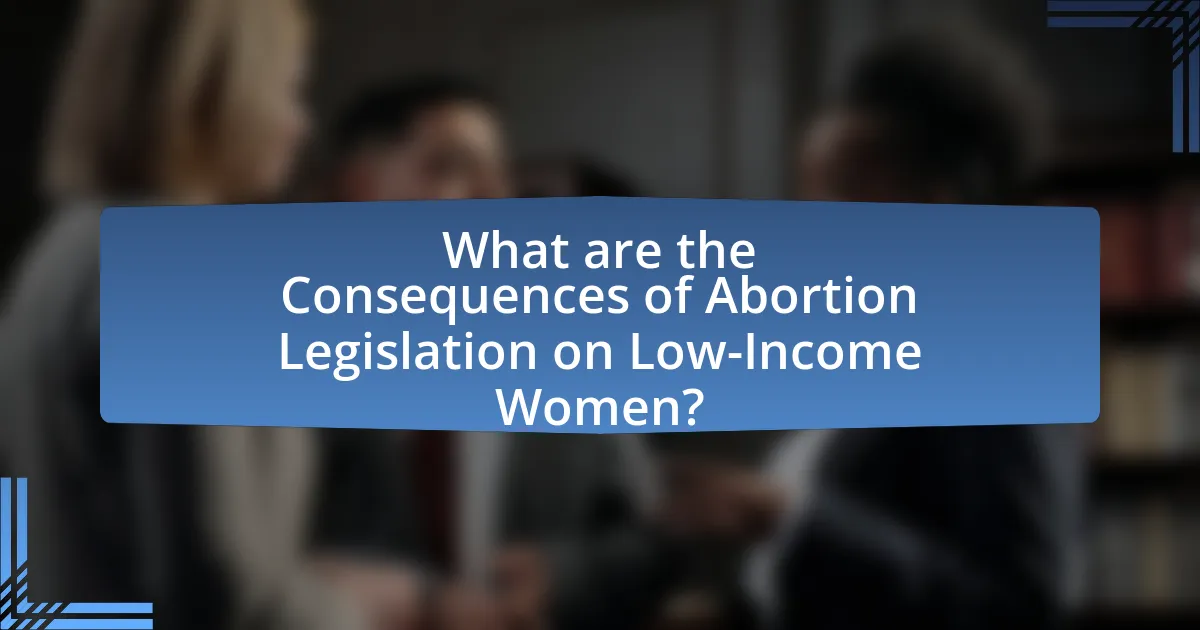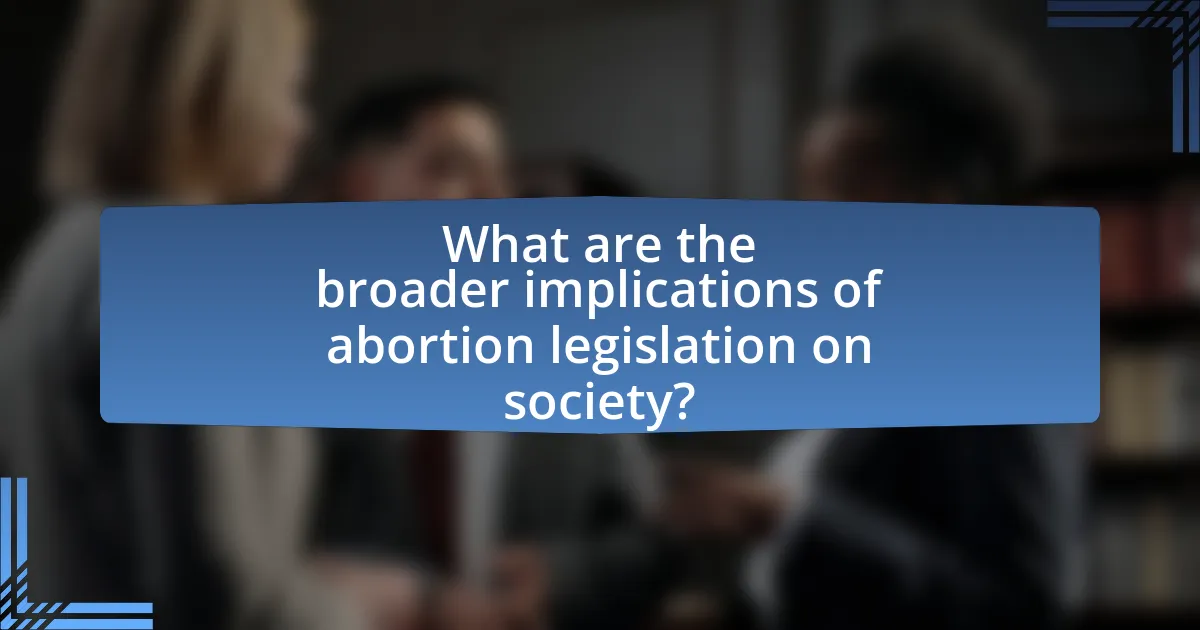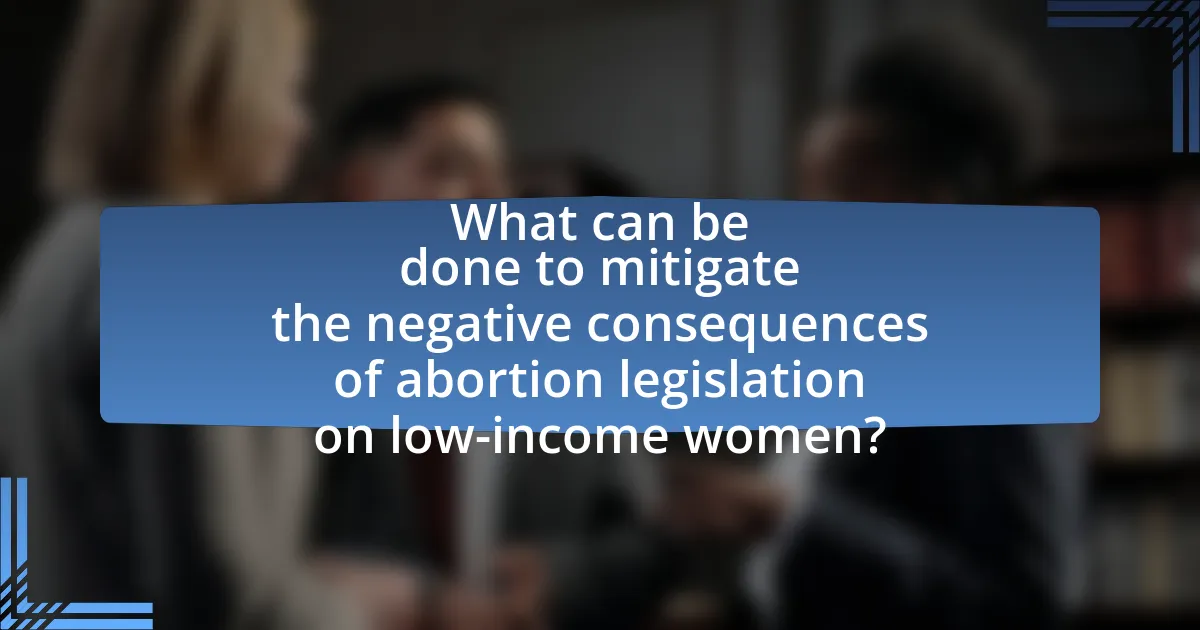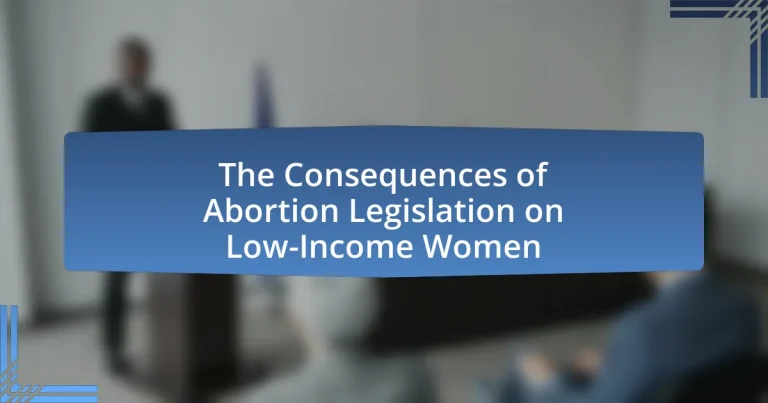The article examines the consequences of abortion legislation on low-income women, highlighting how restrictive laws limit access to safe and legal abortion services, leading to increased health risks and economic hardships. It discusses the financial implications of such legislation, including travel costs and lost wages, which exacerbate existing inequalities and hinder women’s educational and employment opportunities. Additionally, the article explores the social factors contributing to these challenges, such as stigma and lack of education, and emphasizes the broader societal implications, including public health system strain and economic consequences for communities. Finally, it outlines potential advocacy efforts and resources available to support low-income women navigating these legislative challenges.

What are the Consequences of Abortion Legislation on Low-Income Women?
Abortion legislation significantly impacts low-income women by restricting their access to safe and legal abortion services, leading to increased health risks and economic hardships. When states impose strict abortion laws, low-income women often face barriers such as travel costs, lack of nearby clinics, and the inability to afford the procedure, which can result in delayed or unsafe abortions. According to a study published in the American Journal of Public Health, women who are denied abortions are more likely to experience economic instability, with 74% of those denied reporting that they were unable to afford basic living expenses. Additionally, restrictive laws can exacerbate existing inequalities, as low-income women may lack the resources to seek alternative options, further entrenching cycles of poverty and limiting their opportunities for education and employment.
How does abortion legislation specifically impact low-income women?
Abortion legislation significantly impacts low-income women by restricting their access to safe and affordable reproductive healthcare. These women often face financial barriers that make it difficult to obtain abortion services, especially in regions where laws impose waiting periods, mandatory counseling, or limit the availability of clinics. For instance, a study by the Guttmacher Institute found that low-income women are more likely to be affected by state-level restrictions, leading to increased travel distances and costs associated with obtaining an abortion. Additionally, when faced with limited access, low-income women may resort to unsafe methods, which can lead to severe health complications. Thus, restrictive abortion laws disproportionately burden low-income women, exacerbating existing inequalities in healthcare access and outcomes.
What are the financial implications of restrictive abortion laws for low-income women?
Restrictive abortion laws impose significant financial burdens on low-income women, often forcing them to incur high costs for travel, childcare, and medical procedures. For instance, when access to local abortion services is limited, women may need to travel long distances to obtain care, which can lead to expenses exceeding $1,000 in some cases, as reported by the Guttmacher Institute. Additionally, low-income women may face lost wages due to time off work for appointments or recovery, further exacerbating their financial strain. These laws can also lead to increased reliance on public assistance programs, as unintended pregnancies can result in higher healthcare costs and economic instability for these women.
How do access barriers affect the health outcomes of low-income women?
Access barriers significantly worsen the health outcomes of low-income women by limiting their ability to obtain necessary medical care, including reproductive health services. These barriers, which can include financial constraints, lack of transportation, and inadequate health insurance, lead to delayed or foregone medical treatment. For instance, a study published in the American Journal of Public Health found that women facing access barriers are more likely to experience complications during pregnancy and childbirth, as they may not receive timely prenatal care. Additionally, limited access to contraception and abortion services can result in higher rates of unintended pregnancies, further exacerbating health risks. Therefore, the presence of access barriers directly correlates with poorer health outcomes for low-income women, highlighting the critical need for improved healthcare access in this demographic.
What social factors contribute to the consequences of abortion legislation for low-income women?
Social factors such as economic instability, limited access to healthcare, and social stigma significantly contribute to the consequences of abortion legislation for low-income women. Economic instability often forces low-income women to prioritize immediate financial needs over reproductive health, leading to delayed or avoided healthcare services. Limited access to healthcare facilities, particularly in rural or underserved areas, restricts their ability to obtain safe and legal abortions, increasing reliance on unsafe methods. Additionally, social stigma surrounding abortion can lead to isolation and mental health challenges, further complicating their situation. These factors collectively exacerbate the negative impacts of restrictive abortion laws on low-income women, as evidenced by studies showing that women in lower socioeconomic brackets face higher rates of unintended pregnancies and poorer health outcomes when access to abortion is limited.
How does stigma surrounding abortion affect low-income women’s choices?
Stigma surrounding abortion significantly limits low-income women’s choices by creating barriers to accessing necessary healthcare services. This stigma often leads to feelings of shame and isolation, which can deter women from seeking abortions even when they may be the best option for their circumstances. Research indicates that low-income women are more likely to experience negative societal attitudes towards abortion, which can exacerbate their financial and emotional stress, making them less likely to pursue their reproductive rights. For instance, a study published in the American Journal of Public Health found that women who perceive high levels of stigma are less likely to seek abortion services, highlighting the direct impact of societal attitudes on their decision-making processes.
What role does education play in understanding abortion legislation among low-income women?
Education significantly enhances understanding of abortion legislation among low-income women by providing essential knowledge about their rights and available resources. Research indicates that women with higher educational attainment are more likely to be informed about reproductive health policies and legal frameworks, which directly impacts their ability to navigate complex healthcare systems. For instance, a study published in the American Journal of Public Health found that women with a college degree were 50% more likely to understand their reproductive rights compared to those with only a high school education. This understanding is crucial for low-income women, who may face additional barriers such as limited access to healthcare and financial constraints, making education a vital tool for empowerment and informed decision-making regarding abortion options.

What are the broader implications of abortion legislation on society?
Abortion legislation significantly impacts societal structures, particularly in terms of women’s health, economic stability, and social equity. When access to abortion is restricted, low-income women often face increased health risks due to unsafe procedures or unintended pregnancies, which can lead to higher maternal mortality rates. For instance, the World Health Organization reports that unsafe abortions contribute to approximately 47,000 deaths annually worldwide, disproportionately affecting women in low-income brackets.
Moreover, restrictive abortion laws can exacerbate economic disparities, as unplanned pregnancies can hinder women’s educational and employment opportunities, perpetuating cycles of poverty. A study by the Guttmacher Institute found that women who are denied abortions are more likely to experience economic hardship and rely on public assistance.
Socially, abortion legislation can polarize communities, leading to increased stigma around reproductive health and limiting open discussions about women’s rights and health care access. This polarization can hinder progress toward gender equality and reproductive justice, as seen in various regions where restrictive laws have sparked significant public protests and advocacy movements.
How does abortion legislation affect public health systems?
Abortion legislation significantly impacts public health systems by influencing access to reproductive health services and overall maternal health outcomes. Restrictive laws often lead to decreased availability of safe abortion services, which can result in increased rates of unsafe abortions and related complications. For instance, a study published in the American Journal of Public Health found that states with more restrictive abortion laws had higher rates of maternal mortality and morbidity. Additionally, public health systems may face increased costs associated with treating complications from unsafe abortions, thereby straining resources that could be allocated to other health services. This relationship underscores the critical role that abortion legislation plays in shaping the effectiveness and efficiency of public health systems, particularly for low-income women who may have limited access to alternative healthcare options.
What are the long-term health consequences for low-income women denied abortions?
Low-income women denied abortions face significant long-term health consequences, including increased risks of mental health disorders, chronic health issues, and adverse pregnancy outcomes. Research indicates that these women are more likely to experience anxiety, depression, and post-traumatic stress disorder due to the stress of unwanted pregnancies and the challenges of raising children in financially unstable conditions. Additionally, studies show that carrying an unwanted pregnancy to term can lead to higher rates of complications such as preterm birth and low birth weight, which can have lasting effects on both maternal and child health. For instance, a study published in the American Journal of Public Health found that women denied abortions were three times more likely to experience health complications compared to those who received the procedure.
How do these health consequences impact community resources?
Health consequences from abortion legislation significantly strain community resources by increasing demand for healthcare services, mental health support, and social services. For instance, low-income women facing adverse health outcomes due to restricted access to abortion may require more frequent medical visits, leading to higher operational costs for clinics and hospitals. Additionally, studies indicate that communities with limited reproductive health services experience increased rates of unintended pregnancies, which can further burden social services and educational systems. This increased demand can divert funding and resources away from other critical community needs, ultimately impacting overall public health and economic stability.
What are the economic consequences of restricting abortion access?
Restricting abortion access leads to significant economic consequences, particularly for low-income women. These women often face increased financial burdens due to unintended pregnancies, which can result in higher healthcare costs, loss of income, and increased reliance on social services. A study by the Guttmacher Institute found that women denied abortions are more likely to experience economic hardship, with 74% of those denied reporting that they were unable to afford basic living expenses. Additionally, restricted access can limit women’s educational and employment opportunities, further perpetuating cycles of poverty. The economic impact extends beyond individual women, affecting families and communities by increasing the demand for public assistance programs.
How does limited access to abortion services affect workforce participation among low-income women?
Limited access to abortion services negatively impacts workforce participation among low-income women by increasing economic instability and limiting their ability to make choices about family planning. When low-income women face barriers to obtaining abortion services, they may experience unplanned pregnancies, which can lead to increased childcare responsibilities and reduced availability for work. Research indicates that women who have access to abortion services are more likely to pursue education and employment opportunities, as they can better control their reproductive health. For instance, a study published in the American Journal of Public Health found that women who were denied abortions were more likely to experience economic hardship and were less likely to be employed full-time compared to those who had access to abortion services. This evidence underscores the critical link between reproductive rights and economic participation for low-income women.
What are the potential costs to taxpayers associated with increased healthcare needs?
Increased healthcare needs can lead to significant costs for taxpayers, primarily through higher public spending on Medicaid and other government-funded health programs. For instance, when low-income women face barriers to accessing reproductive healthcare, including abortion services, they may experience complications that require more extensive medical treatment, ultimately increasing the financial burden on taxpayers. According to the Guttmacher Institute, states that restrict access to abortion often see higher rates of unintended pregnancies, which can lead to increased costs for prenatal care, childbirth, and postnatal care, all of which are often covered by taxpayer-funded programs. Additionally, the economic impact of increased healthcare needs can strain public resources, leading to higher taxes or reallocation of funds from other essential services.

What can be done to mitigate the negative consequences of abortion legislation on low-income women?
To mitigate the negative consequences of abortion legislation on low-income women, expanding access to comprehensive reproductive healthcare services is essential. This includes providing affordable contraception, prenatal care, and post-abortion support, which can help reduce the need for abortions and support women’s health. Research indicates that states with more comprehensive reproductive health services experience lower rates of unintended pregnancies and abortions, demonstrating the effectiveness of such measures. Additionally, implementing policies that ensure financial assistance for low-income women seeking abortions can alleviate the economic burden imposed by restrictive legislation. Studies show that when financial barriers are reduced, women are more likely to access necessary healthcare services, thereby improving their overall well-being.
What advocacy efforts are currently in place to support low-income women?
Advocacy efforts currently in place to support low-income women include initiatives by organizations such as the National Women’s Law Center and Planned Parenthood, which focus on ensuring access to reproductive health services, including abortion. These organizations provide legal assistance, educational resources, and lobbying efforts aimed at protecting women’s rights and expanding healthcare access. For instance, the National Women’s Law Center has reported that low-income women face significant barriers to accessing abortion services, and their advocacy work aims to address these disparities through policy changes and public awareness campaigns.
How can community organizations assist low-income women facing abortion legislation challenges?
Community organizations can assist low-income women facing abortion legislation challenges by providing financial support, access to healthcare services, and legal assistance. These organizations often offer funding for abortion procedures, which can be crucial for women who cannot afford the costs due to restrictive laws. For example, the National Network of Abortion Funds reports that they help thousands of women each year by covering expenses related to abortion care. Additionally, community organizations can facilitate access to clinics and healthcare providers, ensuring that women receive necessary medical services despite legislative barriers. They also provide legal resources to help women navigate the complexities of abortion laws, which can vary significantly by state. By addressing these critical areas, community organizations play a vital role in supporting low-income women in the face of challenging abortion legislation.
What role do policymakers play in addressing the needs of low-income women regarding abortion access?
Policymakers play a crucial role in addressing the needs of low-income women regarding abortion access by enacting laws and regulations that either facilitate or restrict access to reproductive healthcare services. For instance, policies that expand Medicaid coverage for abortion services can significantly improve access for low-income women, as studies show that financial barriers are a primary reason for limited access to abortion. According to the Guttmacher Institute, states that have implemented Medicaid expansion have seen increased access to abortion services among low-income populations. Conversely, restrictive laws, such as mandatory waiting periods and parental consent requirements, disproportionately affect low-income women, limiting their ability to obtain timely care. Therefore, the actions and decisions of policymakers directly influence the availability and accessibility of abortion services for low-income women.
What resources are available for low-income women affected by abortion legislation?
Low-income women affected by abortion legislation can access various resources, including financial assistance programs, healthcare services, and legal support. Organizations such as the National Abortion Federation provide funding for abortion services, while Planned Parenthood offers comprehensive reproductive health care, including counseling and medical services. Additionally, local nonprofits often provide transportation assistance and support networks to help women navigate the challenges posed by restrictive abortion laws. According to the Guttmacher Institute, nearly 75% of women who seek abortions are low-income, highlighting the critical need for these resources to ensure access to safe and legal abortion services.
How can low-income women access financial assistance for reproductive health services?
Low-income women can access financial assistance for reproductive health services through government programs, non-profit organizations, and community health centers. Programs such as Medicaid provide coverage for reproductive health services, including family planning and prenatal care, to eligible low-income individuals. Additionally, organizations like Planned Parenthood offer sliding scale fees based on income, ensuring that services remain affordable. Community health centers often receive federal funding to provide comprehensive reproductive health services at reduced costs, making them accessible to low-income women. According to the Guttmacher Institute, nearly 75% of women who seek care at these centers are low-income, highlighting their critical role in providing necessary reproductive health services.
What support networks exist for low-income women navigating abortion-related challenges?
Support networks for low-income women navigating abortion-related challenges include organizations such as the National Network of Abortion Funds, which provides financial assistance and logistical support for accessing abortion services. Additionally, local clinics often collaborate with community organizations to offer resources like counseling, transportation, and legal aid. Research indicates that these networks are crucial, as low-income women face significant barriers, including financial constraints and limited access to healthcare services, which can exacerbate the challenges associated with abortion.


